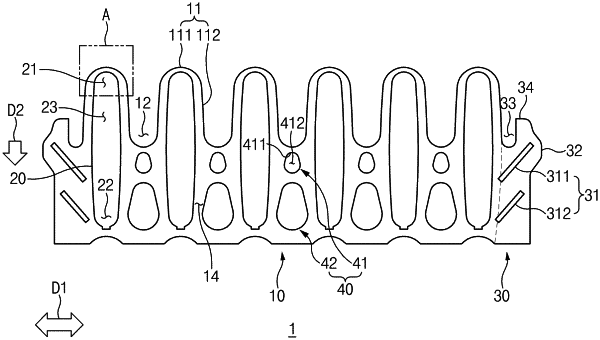| CPC F28F 1/325 (2013.01) [F28F 2215/08 (2013.01); F28F 2215/10 (2013.01)] | 17 Claims |

|
1. A heat transfer fin comprising:
a fin body having a plate shape with a planar surface; and
a plurality of through-holes formed through the fin body and spaced apart from each other in a first direction along the planar surface of the fin body,
wherein, when the flow direction of combustion gas that is to flow along the planar a surface of the fin body is referred to as a second direction, the fin body includes a distal surrounding part configured to surround a first distal area located at the farthest upstream side of each of the through-holes with respect to the second direction and middle surrounding parts extending from the distal surrounding part,
wherein the shortest distance between an inner boundary and an outer boundary of the distal surrounding part that is obtained in an area of the distal surrounding part that is located at the farthest upstream side with respect to the second direction is smaller than the shortest distance between the inner boundary and the outer boundary that is obtained in an area of the distal surrounding part that is located at the farthest downstream side with respect to the second direction, and
wherein the shortest distance between the inner boundaries and the outer boundaries of the middle surrounding parts is bigger than or equal to the farthest distance between the inner boundary and the outer boundary of the distal surrounding part, and
wherein the shortest distance from any point on the inner boundary of the distal surrounding part to the outer boundary of the distal surrounding part decreases as the point moves along the inner boundary of the distal surrounding part in a direction that is opposite to the second direction.
|